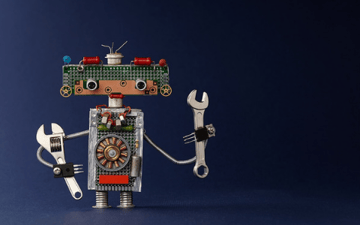In the first article of this two-part series, we examined the relationship between Quality Management (QM) and Enterprise Maintenance. Today, we’ll look ahead to the future of QM as we progress further into the era of Industry 4.0.
Looking to the future: maintenance for quality in the era of digitization (Industry 4.0)
Enterprise Maintenance has always been a key ingredient of Quality Management, but the expanded digitization of enterprise operations is making the relationship between maintenance and quality much closer and more symbiotic.
Specifically, the availability of large volumes of digital data about processes and the equipment enables maintenance engineers to gain deeper insights on how maintenance affects quality and vice versa.
The rise of Artificial Intelligence (AI) is destined to exploit this knowledge to increase automation and reduce work-heavy, error-prone operations. Overall, the digitization of industrial processes will change the way maintenance affects quality management.
Here are just a few of the changes we can expect to see on the near horizon:
#1: Facilitating employees’ engagement and increasing their safety.
Employees’ engagement will remain one critical success factor for Quality Management programs. This is because maintenance workers will have to supervise the operation of machines and making the final maintenance planning decisions. We will see fewer employees conducting repetitive, laborious tasks (e.g., operating conveyors and forklifts) and will see the shift of their roles towards quality planning and monitoring tasks. This will have several positive effects on the safety and the overall satisfaction of maintenance employees and field workers.
#2: Increasing automation will reduce human error.
The digitization of industrial processes enables the development of AI systems that automatically detect failures, and instantly initiate remedial actions (e.g., changing production schedules, analyzing trends to optimize scheduling maintenance activities, placing orders for spare parts).
In this way, the maintenance part of the quality management processes (both inspections and reactive actions) will soon become more automated and less reliant on – possibly in some areas even independent from – human interventions, which means the possibility of user error decreases significantly.
#3: Predict production quality problems before they occur.
When some people hear the word “data”, their eyes gloss over. But by collecting such large amounts of data about the status and operation of plant equipment will enable us to deploy predictive analytics algorithms. These algorithms will give us the ability to anticipate equipment failures and malfunctions, as well as predict defects in the products produced. Therefore, quality management processes will become more proactive and less reactive than they are today.
#4: Identify and remedy previously unknown problems.
They say the biggest problem is the one you don’t even know exists. Based on Big Data technologies, Maintenance Engineers will be soon able to gain deep knowledge and insights in the maintenance processes, such as knowledge on degradation and defect patterns, including potentially hidden patterns that were previously unknown. By taking advantage of such knowledge, intelligent maintenance functions can be implemented, which empowers cognitive maintenance operations.
#5: Traceability, transparency and introduction of new dimensions in production quality.
The increasing availability of digital data about the equipment throughout its lifecycle makes it possible to continually track and trace the condition of machines and tools, rather than only being able to ascertain its condition during an inspection. This will enable the traceability of maintenance, repair and field service operations throughout the entire lifecycle of a production order.
Furthermore, this traceability information could be also shared with the customers as a means of assuring the quality of the products and subsequently strengthening the trust between the plant operator and its customers. In the longer-term, this transparency could provide customers with greater visibility on the production processes, as well as with the ability to define and track their own dimensions of product quality (e.g., dimensions associated with the precision, calibration information of equipment/tools used during manufacturing, etc.).
When Enterprise Maintenance and QM come together: power in the hands of the people
Overall, the digital transformation of industrial plants holds the promise to completely disrupt quality management, towards the concept of autonomous, customer-defined quality. The new age of digitization puts more power in the hands of people, while increasingly relying on AI and other digital mechanisms to do the heavy lifting – figuratively and literally.
Knowing this potential, it’s time for enterprise maintenance professionals in all industries to start considering maintenance as a vehicle for excellence in Quality Management and synchronizing the organization’s maintenance and quality goals and processes. The results will improve the efficiency of your operations, while increasing your customers’ satisfaction.



